Are you ready for a tomato harvest? Here are some tips to make tomato plants grow faster this summer.
You waited for weeks for your tomato seedlings to sprout and grow. Now, they’re in your vegetable garden, and you’re waiting impatiently for ripe fruits. There are a few things you can do to make tomato plants grow faster!
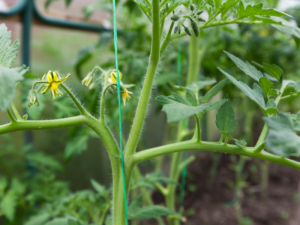
Growing tomato plants is science. We know what tomato plants need to grow and mature successfully, and if you provide plants with what they need, you will have a bumper crop.
Tomato plants need rich, well-draining soil that is high in organic matter. Mixing compost or aged manure into your soil gives plants a healthy boost. Ensuring your tomatoes get at least six hours of direct sunlight per day.
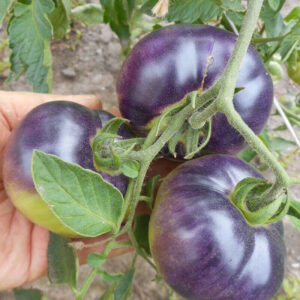
If you don’t have a space with that much sunlight, consider growing tomatoes in a container and moving the pot around.
Don’t forget to water properly! Proper watering gives your plants consistent moisture, but at the same time, tomato plants dislike being overwatered and having soggy roots.
Keep reading to learn all of the ways to make tomato plants grow faster!
How Long Do Tomatoes Take to Grow?
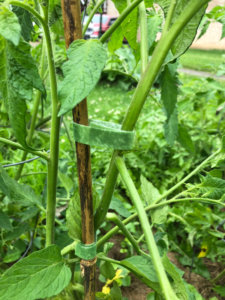
Before you plant tomatoes and look up ways to make tomato plants grow faster, it’s important to have realistic expectations.
When you plant tomato seeds indoors, take a look at the packet. It will list something that says “days to maturity,” which is a general estimate of how long it will take the tomatoes to be ripe for picking. However, the countdown to days to maturity starts when you transplant your tomato seedlings into the garden, not when you start the seeds indoors.
Most gardeners start tomato seedlings indoors six to eight weeks before the last frost date. Then, they begin transplanting into the garden. In general, you should add 40-55 days to the “days to maturity” listed on the seed packet.
How long it takes for your plants to produce fruits also varies significantly based on your environment and the type of tomatoes you grow.
Some tomatoes are ready for harvest in 60-80 days; these are often determinate plants. The fruits all come to harvest within a short period; it’s an intense yet fruitful harvest.
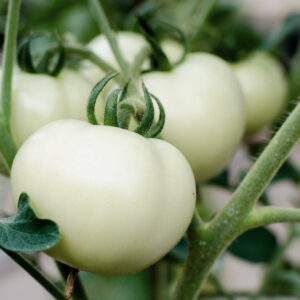 vg
vg
Cherry tomatoes also tend to produce faster than beefsteak tomatoes, which makes sense! Beefsteak tomatoes may weigh a pound or more each!
Indeterminate tomatoes generally take a bit longer to produce fruit, starting 80-100 days after transplanting into garden beds. These tomato types will steadily produce a tomato crop until the plants die.
How to Make Tomato Plants Grow Faster
1. Pick Early Maturing Tomato Plants
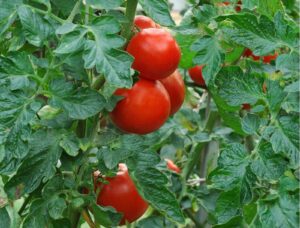
A few other among many early-maturing tomato varieties include:
- Early Cascade
- Bloody Butcher
- Sun Gold
- Yellow Nugget
2. Make Sure You Have Warm Soil

Temperature is an essential factor that will make tomato plants grow faster. The warmer the soil and temperature outside, the better they will grow.
You can’t control Mother Nature, but tomato plants grow best when nighttime temperatures are at least 50 degrees F. Daytime temperatures should be between 70 to 85 degrees F for ideal growth.
Soil temperature is something you can control more. Use a soil thermometer to determine the temperature, and you can use straw around your plants to provide more insulation against cold temperatures.
You also can use black plastic to heat up the soil before planting to make it warmer. Laying down black plastic before transplanting to 41 degrees F beforehand.
However, black plastic mulch has a negative environmental impact. It leaches chemicals into your soil when exposed to hot summer sun.
3. Plant Tomato Seedlings Deeply in the Soil
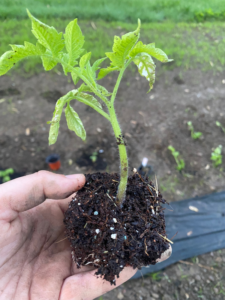
When it’s time to harden and transplant your seedlings, make sure you bury the seedlings deeply in the soil. Deeply planted tomato seedlings lead to a strong root system.
Strong roots will lead to vigorous growth and a stronger plant overall. When I transplant my seedlings into the garden beds, I make sure to remove the bottom leaves; at least half of the plant is buried under the soil.
4. Optimizing Soil Conditions
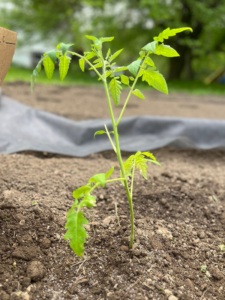
To ensure that tomato plants grow faster, optimizing soil conditions is crucial. As a gardener, I have found that the following tips have been helpful in creating the ideal soil environment for tomato plants:

- Test Soil pH: Tomatoes thrive in soil with a pH range of 6.0 to 6.8. Testing the soil’s pH level can help determine whether it is too acidic or alkaline. If the pH level is too low, adding lime can help raise the pH level. On the other hand, if the pH level is too high, adding sulfur can help lower it.
- Test for Nutrients: Before making alterations, you should also test for nutrients. If your plant has high enough calcium levels, you know you can skip any amendments with calcium. Adding too much to your plants is just as detrimental to the growth of your plants.
- Add Compost: Adding compost to the soil can help improve its structure, texture, and nutrient content. Compost can be made at home by using kitchen scraps, yard waste, and other organic matter. It is also readily available at local garden centers.
- Use Fertilizer: Fertilizer can help provide the necessary nutrients that tomato plants need to grow faster. A balanced fertilizer with equal amounts of nitrogen, phosphorus, and potassium is ideal for tomato plants. However, it is important not to over-fertilize as this can lead to the burning of the plants.
5. Lay Down Organic Mulch

Mulching the soil can help retain moisture and regulate soil temperature. This can be done using organic materials such as straw, leaves, or grass clippings. Mulching can also help suppress weed growth, which can compete with tomato plants for nutrients.
However, when applied too slowly, it can slow down the growth of your plants. Straw, newspaper, and cardboard are great choices because they provide insulation to your soil surface while also keeping the soil moist and cool during the summer heat.
Once my plants are two feet tall, I put a thick layer of mulch over the soil. I prefer wood chips, but everyone has a preference. Some people even use leftover wool from shearing their sheep!
6. Providing Adequate Water
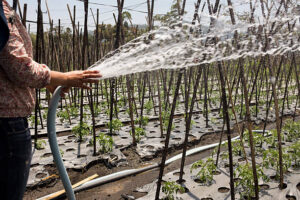
Water is essential for the growth of tomato plants. As the plants grow, they will need more and more water to thrive. If you don’t provide enough water, the plants will wilt and die. On the other hand, if you over-water them, you risk drowning the roots and causing root rot.
I make sure to water my tomato plants deeply and regularly, about once or twice a week, depending on the weather. When it’s hot and dry, I water them more often. When it’s cool and rainy, I water them less often. I also make sure to water them in the morning, so the leaves have time to dry before nightfall.
I use a watering can or a hose with a watering wand to water my tomato plants. I avoid using a sprinkler, as it can waste water and may not provide enough water to the roots.
To make sure my tomato plants get enough water, I check the soil moisture regularly. I stick my finger into the soil up to the second knuckle. If the soil feels dry, it’s time to water. If it feels moist, I wait a day or two before checking again.
7. Ensuring Sufficient Sunlight
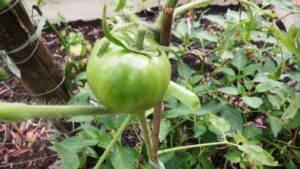
To make tomato plants grow faster, it is important to provide them with enough sunlight. As a gardener, I have found that tomato plants need at least six hours of direct sunlight each day to grow well.
Here are some tips to help ensure sufficient sunlight for your tomato plants:
- Choose the right location: When selecting a spot for your tomato plants, choose a location that receives plenty of sunlight throughout the day. Avoid planting them in areas that are shaded by trees or buildings.
- Prune surrounding plants: If any surrounding plants are blocking sunlight from reaching your tomato plants, prune them back to allow more light in.
- Use reflective materials: Placing reflective materials around your tomato plants can help reflect sunlight onto them. For example, aluminum foil or white plastic mulch can reflect sunlight onto your plants.
- Rotate your plants: If your tomato plants are not getting enough sunlight in their current location, try rotating them to a sunnier spot in your garden.
8. Applying Fertilizer
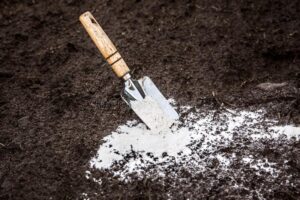
When it comes to growing tomato plants, applying fertilizer is essential to ensure healthy growth and a bountiful harvest. Tomatoes are heavy feeders, so they need plenty of nutrients to grow.
Here are some tips on how to apply fertilizer to your tomato plants:
- Choose the right fertilizer: There are various types of fertilizers available in the market, but not all of them are suitable for tomato plants. Look for a fertilizer that is high in nitrogen, phosphorus, and potassium, which are the essential nutrients that tomato plants need to grow.
- Apply fertilizer at the right time: Apply fertilizer when the plants are actively growing, which is usually 3-4 weeks after transplanting. Avoid applying fertilizer during the flowering stage, as it can lead to excessive foliage growth and fewer fruits.
- Apply fertilizer evenly: Spread the fertilizer evenly around the plant’s base, ensuring not to get it on the leaves or stem. You can also mix the fertilizer with water and apply it directly to the soil.
- Do not over-fertilize: Over-fertilizing can lead to excessive foliage growth and fewer fruits. Follow the instructions on the fertilizer package, and do not exceed the recommended amount.
- Use organic fertilizers: Organic fertilizers are a great option for those who want to avoid synthetic chemicals. They are made from natural ingredients such as compost, manure, and bone meal and release nutrients slowly to the plants.
9. Trellis Indeterminate Tomato Varieties
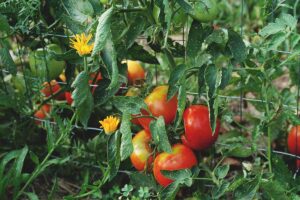
Indeterminate tomato varieties are wild, and they need ample space to grow. So, you need sturdy a sturdy trellis to handle the plants.
Trellising plants and keeping them off the ground has several advantages.
First, it decreases the risk of soil-borne diseases. Pathogens live in the soil, and when the plant lays on the soil, you increase the risk of your plant getting sick. Fungal diseases are more likely to infect your plants if they touch the dirt.
Another benefit is that it increases the amount of light your plant receives, which helps quicken the ripening of the fruits. Also, it allows more airflow around your plant, keeping the plant healthier all over.
10. Pruning Tomato Plants
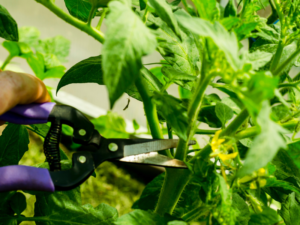
Pruning and training your tomato plants can help them grow faster and produce more fruit.
Here are some tips for pruning and training your tomato plants:
- Remove suckers: Suckers are the small shoots that grow in the crotch between the stem and the branch of your tomato plant. They do not produce fruit and can take away energy from the rest of the plant. By removing them, you can help your plant focus its energy on growing bigger and producing more fruit.
- Stake or cage your plants: Tomato plants can get heavy as they grow, and their branches can break under the weight of the fruit. Staking or caging your plants can help support them and keep them upright. You can use bamboo stakes, metal cages, or even old tomato cages to support your plants.
- Prune the lower branches: As your tomato plant grows, it may produce branches that are close to the ground. These lower leaves can be more susceptible to disease and pests and can also take away energy from the rest of the plant. Pruning these lower branches can help improve air circulation and sunlight exposure to the rest of the plant.
- Pinch off the top of the plant: Once your tomato plant has reached a certain height, you can pinch off the top of the plant to encourage it to focus on producing fruit. This can help your plant produce more fruit, and can also help prevent it from getting too tall and top-heavy.
Remember always to use clean, sharp pruning tools, and to prune your plants early in the morning or late in the day to avoid damaging them in the heat of the day. If you don’t clean your tools, you risk passing diseases from one plant to another!
11. Keep an Eye Out for Pests
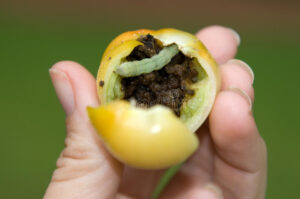
Tomato pests love to munch on your tomato plants. Slugs, aphids, hornworms, whiteflies, and other pests will devour your plant, or simply suck out valuable nutrients, slowing the overall development.
Watch for signs of insect damage, but first, actively work to keep pests away from your ripe tomatoes in the first place.
Companion planting helps deter plants, and you can try planting trap crops away from your plants to encourage the insects to eat them. You also can try floating row covers to protect your plants from an infestation. Tomato plants are self-pollinating, so floating row covers may only slightly decrease your yield.

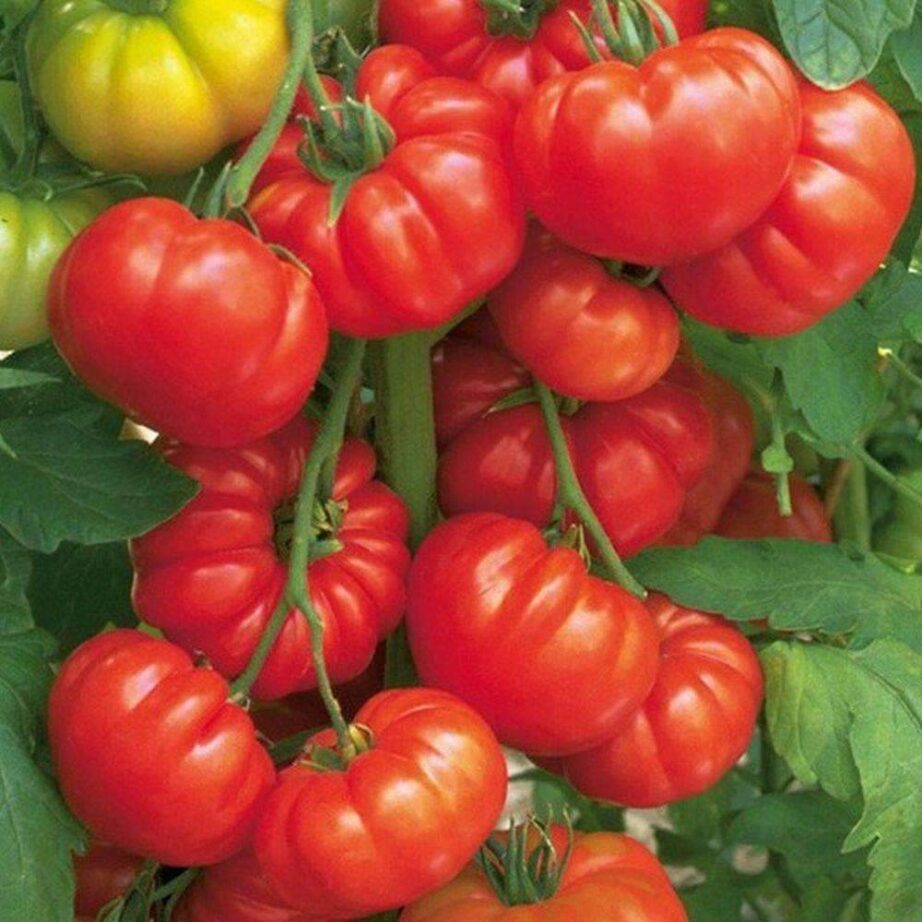
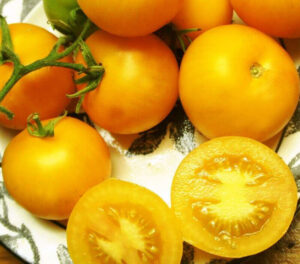
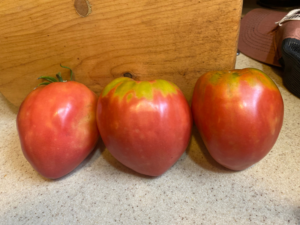
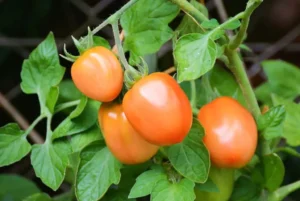
 Any questions or if buying, contact me
Any questions or if buying, contact me
Recent Comments